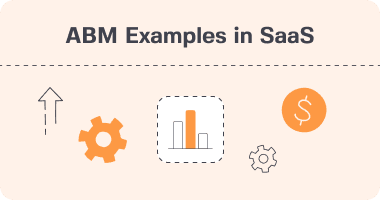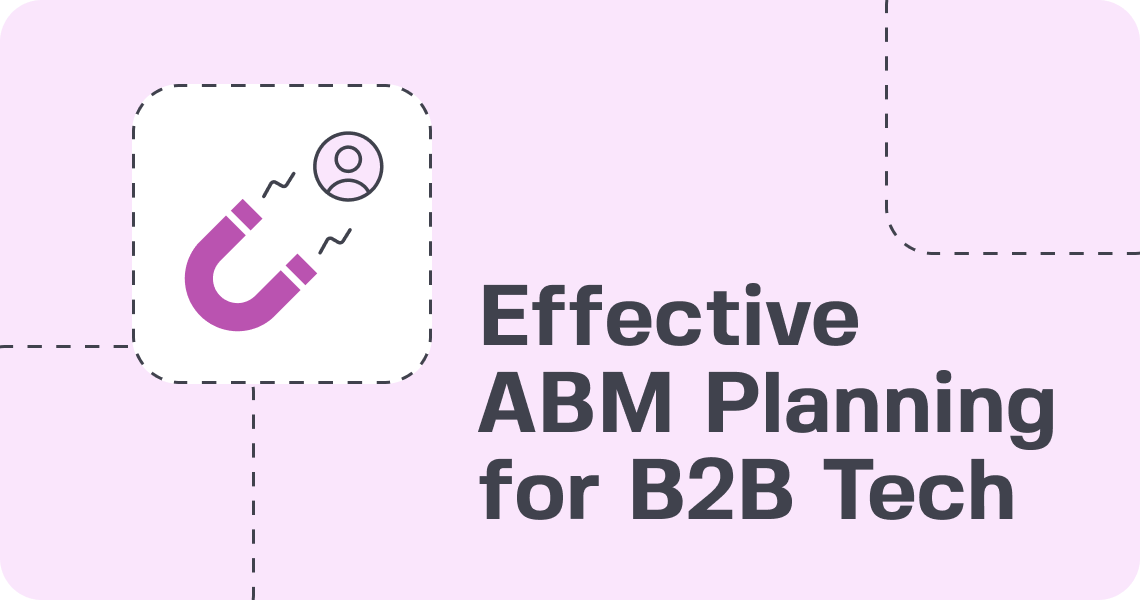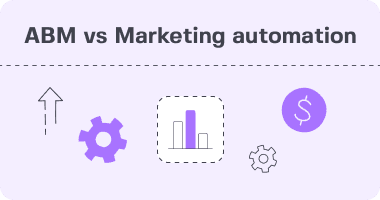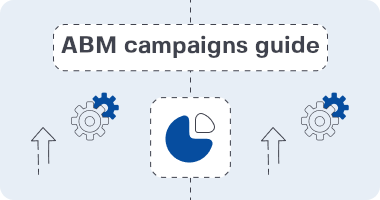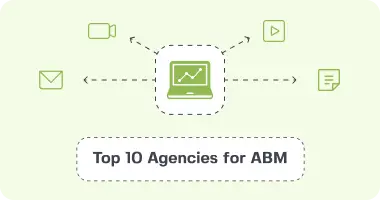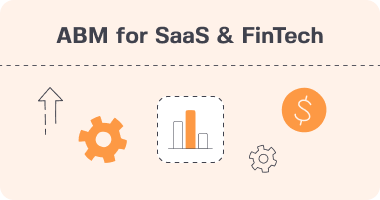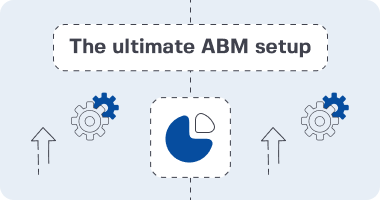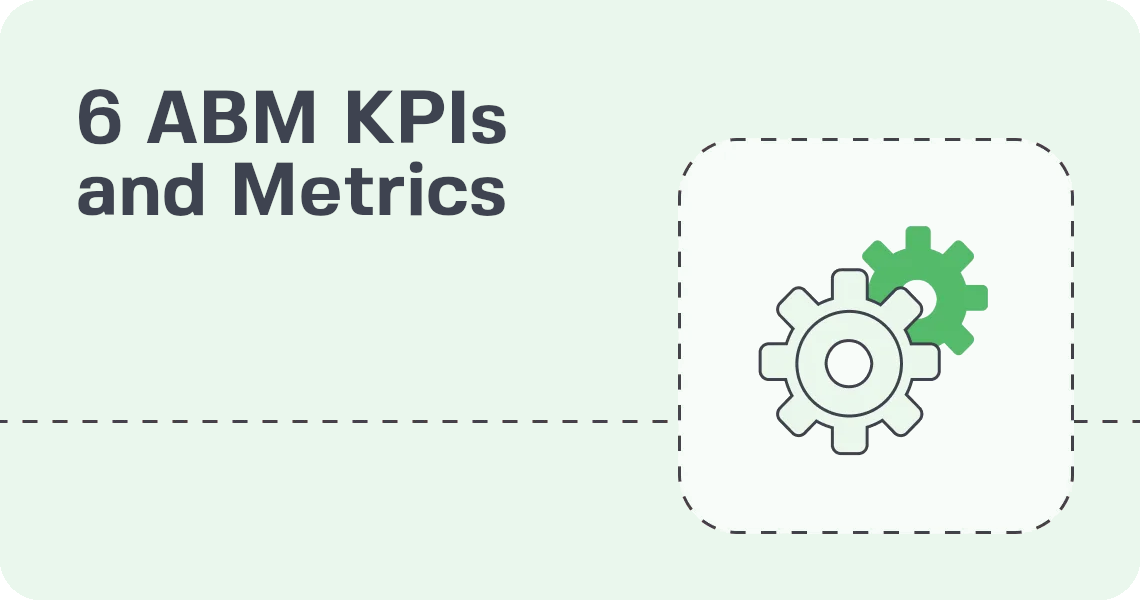ABM attribution would include measuring and tracking the effects of such actions. It illustrates the impact those actions have on pipeline-generating key accounts in an account-based marketing playbook. To improve attribution, it is essential to accurately measure the impact of marketing actions and understand which efforts drive results.
In our experience, these traditional metrics leave us wanting, especially when we need to prove true impact or get an idea of how accounts are engaging.
We strived for nuanced attribution to better align our marketing efforts with our business goals and with sales teams to improve ABM strategies. It uncovers more meaningful connections and fosters more impactful customer relationships.
Here’s why it’s critically important to get ABM attribution right this time around.
What is ABM Attribution?
ABM attribution is the key to measuring the true effectiveness of our account-based marketing campaigns. We use it to pinpoint the marketing activities that actually move the needle, allowing us to prioritize the accounts that are most valuable to our success. Collaboration between marketing and sales teams enhances campaign effectiveness and ensures more accurate attribution across the entire account lifecycle.
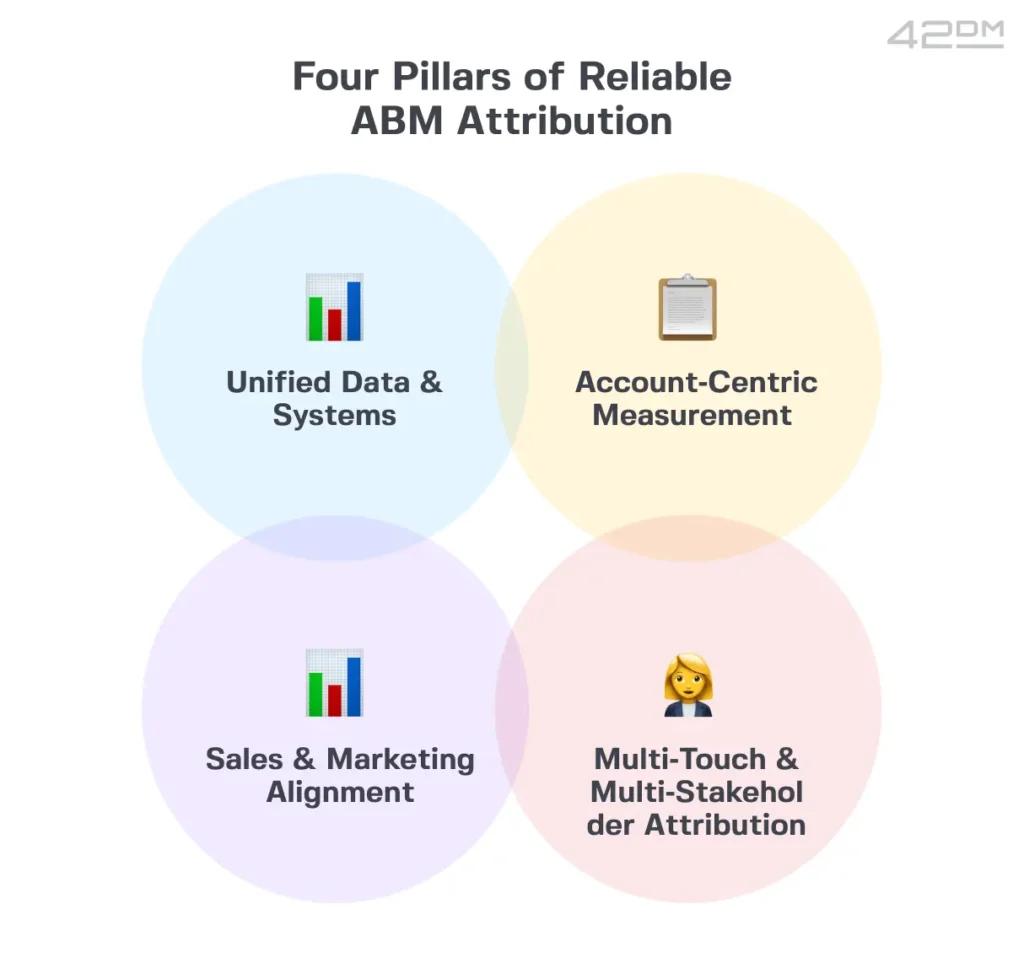
What makes ABM attribution different from traditional attribution? It provides a very simple, data-forward approach to get sales and marketing on the same page around common metrics, rather than chasing after single leads or lead counting on arbitrary touchpoints. This helps us get a more holistic view of how each target account moves from that initial outreach all the way through to a closed, won deal. Mapping the buyer’s journey across multiple touchpoints is essential for effective ABM attribution, as it allows us to analyze and optimize every stage of the process. That journey could be a web of website visits, LinkedIn advertising, in-person events, or just plain-worded referrals!
1. Defining Account-Centric Measurement
We measure by focusing on the whole account, rather than people within it. This fits perfectly with how B2B buying decisions are actually made—by committees, not by mavericks. Our measurement follows the full customer journey, tracking every touchpoint: from a white paper download to a meeting booked. Tracking all marketing touchpoints is essential to understand how each interaction contributes to the customer journey and influences conversion.
Think of it like charting each pit stop on a trip across the country. So stop only measuring the first mile and the last! This allows us to identify where representations of engagement occur, analyze each customer interaction to optimize engagement, as well as where it begins to lose interest.
2. Its Core Purpose: True Impact
At its core, ABM attribution is about cutting through the noise. How can we truly measure that impact without the proper attribution in place? Actionable insights—such as identifying an increase in engagement due to a targeted webinar—allow us to be responsive and make smart, informed investments.
3. Key Metrics That Really Count
We focus on metrics that reflect account progress:
- Account engagement scores
- Opportunity creation rate
- Pipeline velocity
- Multi-touch influence
- Account-level conversions
- Customer acquisition cost (to measure and optimize ROI, and improve budgeting and campaign efficiency through better attribution models)
These provide insight into what works, and this allows us to adjust budgets accordingly. Putting money towards the activities that prove to be the most beneficial.
4. Proving Marketing’s Actual ROI
Showing ROI is non-negotiable. We monitor each touchpoint down to the email opens, webinar registrations, and sales calls. After that, we deploy customized attribution models—first-touch, linear, U-shaped, last touch attribution, and first touch attribution—to illustrate which touches are driving accounts further down the line. Both first touch attribution and last touch attribution assign all the credit to a single interaction—either the initial or final touchpoint—making them simple to implement but limited in capturing the full customer journey and the contribution of multiple touchpoints.
Without clear ROI, we’re swimming upstream when it comes to making the case for more investment and more strategic, data-driven approaches.
5. Tracking Full Account Engagement
We are big fans of tools that track every interaction, both virtual and in-person, ensuring no touchpoint is ever missed. It’s important to capture not only regular digital touchpoints, but also informal and invisible channels—such as word-of-mouth, podcasts, or offline conversations—that can significantly influence the customer journey. This complete account perspective is key to knowing what actually moves the needle with decision-makers.
We’ve learned that consistent naming and data hygiene are absolutely key, because without them our insights completely fall apart.
ABM vs. Traditional Attribution
What we’re seeing is a big chasm in marketing approaches. Account-based marketing (ABM) attribution is not like the traditional lead-centric models that most of us are all too familiar with. Unlike traditional attribution models, account-based marketing attribution is designed to measure and optimize the impact on specific target accounts rather than just tracking individual leads. Classic attribution is surface-level at best, counting leads and measuring what general campaigns get someone to bite.
Conversely, ABM attribution takes things personal—it focuses specifically on accounts, not just people. While traditional attribution models are centered on individual leads, account-based marketing attribution is tailored to specific target accounts, ensuring that every touchpoint and interaction is mapped to the organizations that matter most. This change is particularly pressing in B2B contexts, where the customer journey is almost never a one-person show. The average deal involves multiple stakeholders, countless touchpoints (think: LinkedIn ads, white paper downloads, referrals over coffee), and a maze of offline and online engagement.
Focus: Account, Not Just Lead
Shifting the emphasis from leads to accounts entirely upends the playing field. No more chasing after lost contacts; we create connections that count, with the whole buying team. This new approach allows our outreach and content to be extremely hyper-personalized.
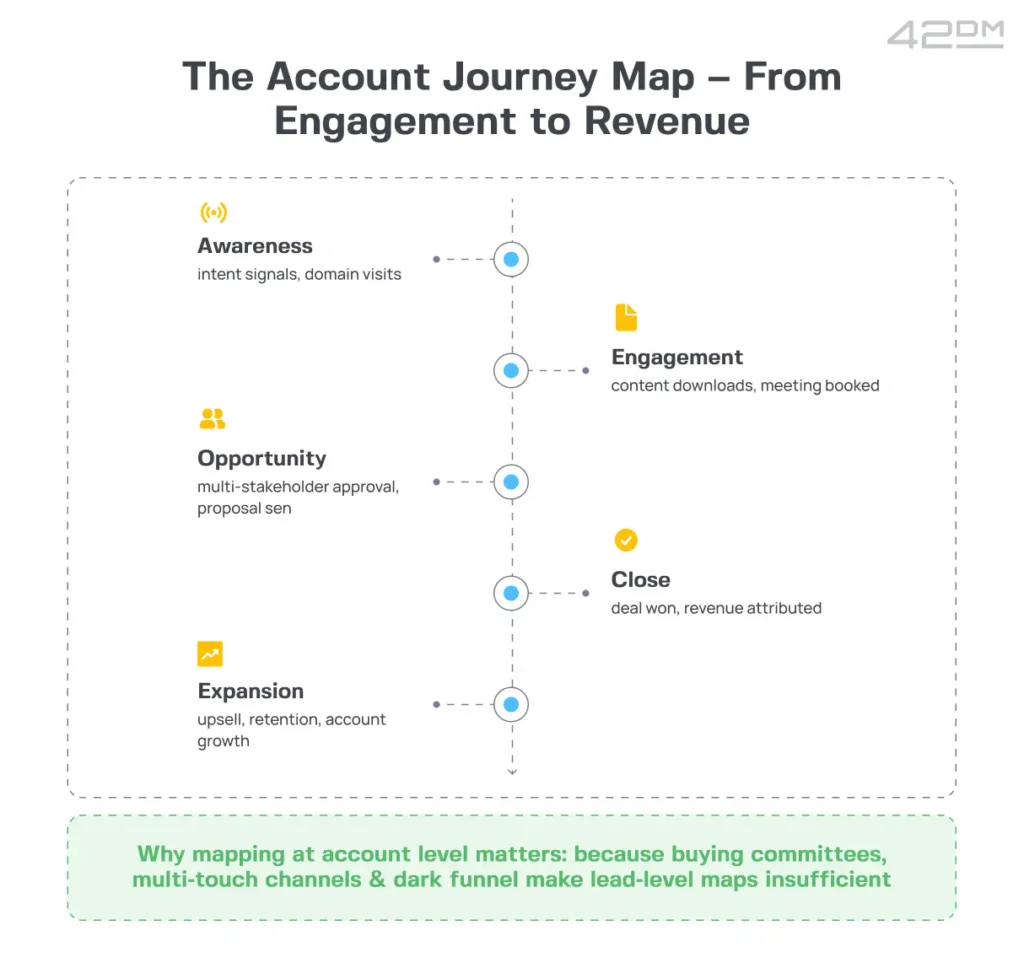
We focus on the real pain points and interests of every account, every time, not just a broad audience. ABM strategies enable us to tailor messaging to each stage of the buying process for every account, ensuring our communication is always relevant and effective. Through this process, we build trust and loyalty, allowing us to become true partners instead of just another vendor. Our entire marketing approach changes from spray and pray to seed and grow.
In our experience, it’s this no-nonsense approach that eventually yields much sweeter, long-term victories.
Understanding Complex Buying Groups
B2B deals almost never depend on just one individual. A typical buying committee could consist of a director, a tech lead, and a procurement manager—each with unique priorities. Understanding the buying process and integrating sales outreach efforts is crucial for effective ABM attribution. ABM attribution allows us to visualize these dynamics.
We can now tell which campaigns are most effective with which stakeholders, allowing us to better customize our outreach for each persona. By pinpointing important influencers within accounts, we’re able to make our campaigns more personalized and timely, increasing engagement and decreasing sales cycles.
Justifying Your ABM Investment
ABM requires a lot of resources. We put far more time and energy into the beginning, but accurate attribution is the proof of the return on investment. By measuring revenue and engagement based on the account, we’re able to clearly illustrate which initiatives are having the biggest impact. Tracking how much revenue is generated from specific campaigns using attribution data helps demonstrate the effectiveness of each marketing effort.
Telling these wins back to leadership—again with data not just gut feel—earns you the continued support and budget.
Key ABM Attribution Models
When we talk about ABM attribution, we’re really talking about how to measure the impact of the marketing and sales activities we are driving. This important connection then shows the revenue outcomes that really count. That’s where ABM attribution models come in—they allow us to follow the journey of each account. An account-based marketing framework helps track and optimize the impact of marketing efforts on target accounts by measuring which channels and touchpoints contribute most to conversions and engagement.
They show you what touchpoints—webinars, white paper downloads, or that one custom sales demo (the one that finally made something happen)—actually count. Choosing the appropriate model isn’t solely a technical decision. It’s more about fitting it to our business objectives, the makeup of our team, and the level of complexity of the buying journey we’re working on.
Single-Touch vs. Multi-Touch Views
We view single-touch models (first-touch, last-touch) as basic attribution models—ideal for simple journeys or scenarios where one channel is the clear winner. They fail to capture the complexity of B2B buying where many stakeholders and touchpoints are involved. Single-touch models assign all credit to either the initial interaction or the last touch, which may not reflect the full sales funnel or account for the influence of previous interactions.
Multi-touch models (linear, time decay, U-shaped) consider the entire journey, distributing credit evenly among all touchpoints. Multi-touch provides us the nuance necessary for long cycles, or whenever our campaigns cross digital and offline channels. That said, single-touch can be useful in low-hanging fruit situations, such as event-triggered campaigns.
Popular Multi-Touch Model Types
Here’s how some common models stack up:
| Model | How it Works | Best For |
| Linear | Spreads credit evenly | Balanced, steady nurturing |
| Time Decay | More credit to recent touchpoints | Long cycles, late-stage urgency |
| U-Shaped | Emphasizes first and lead conversion | Identifying kickoff and handoff |
| Custom | Tailored weighting by activity | Unique journeys, complex teams |
Multi-touch models give us insight into the activities that truly fuel engagement, rather than first or last click. They can also account for the influence of a blog or website visit as a key touchpoint in the customer journey, helping to measure how these interactions contribute to conversions.
Customizing Your Business’s Model
Customization is key. No two ABM programs are the same. We advise customizing your attribution framework not just by buying committee role, but by sales motion, and yes—even by your CRM setup. Leverage CRM data and consolidate all your data from various sources—such as CRMs, websites, marketing automation strategies, and ad platforms—to improve attribution accuracy.
Consider quality of data, how long your average sales cycle tends to be, and which channels are most important. Aligning your model to your unique marketing activities is key to making sure you aren’t just measuring, you’re measuring what matters.
Which Models Fit ABM Best?
For ABM, custom multi-touch and U-shaped models really tend to excel. They accurately reflect the complexity of account engagement and place importance on high-value actions. Tracking account level engagement and measuring success through aligned metrics across sales and marketing teams are essential for evaluating campaign effectiveness and driving continuous improvement.
Modeling ABM takes flexibility to be effective. As your campaigns evolve, so must your model. It’s an evolving practice, requiring the right sales-marketing alignment and continuous data refinement.
Navigating ABM Attribution Challenges
ABM attribution is like putting a jigsaw puzzle together. A few important pieces are still missing, and the picture continues to evolve! We have to walk the line between in-person discussions and digital intent. Navigating this impressive cast of stakeholders often seems like the whole New Jersey Turnpike at rush hour!
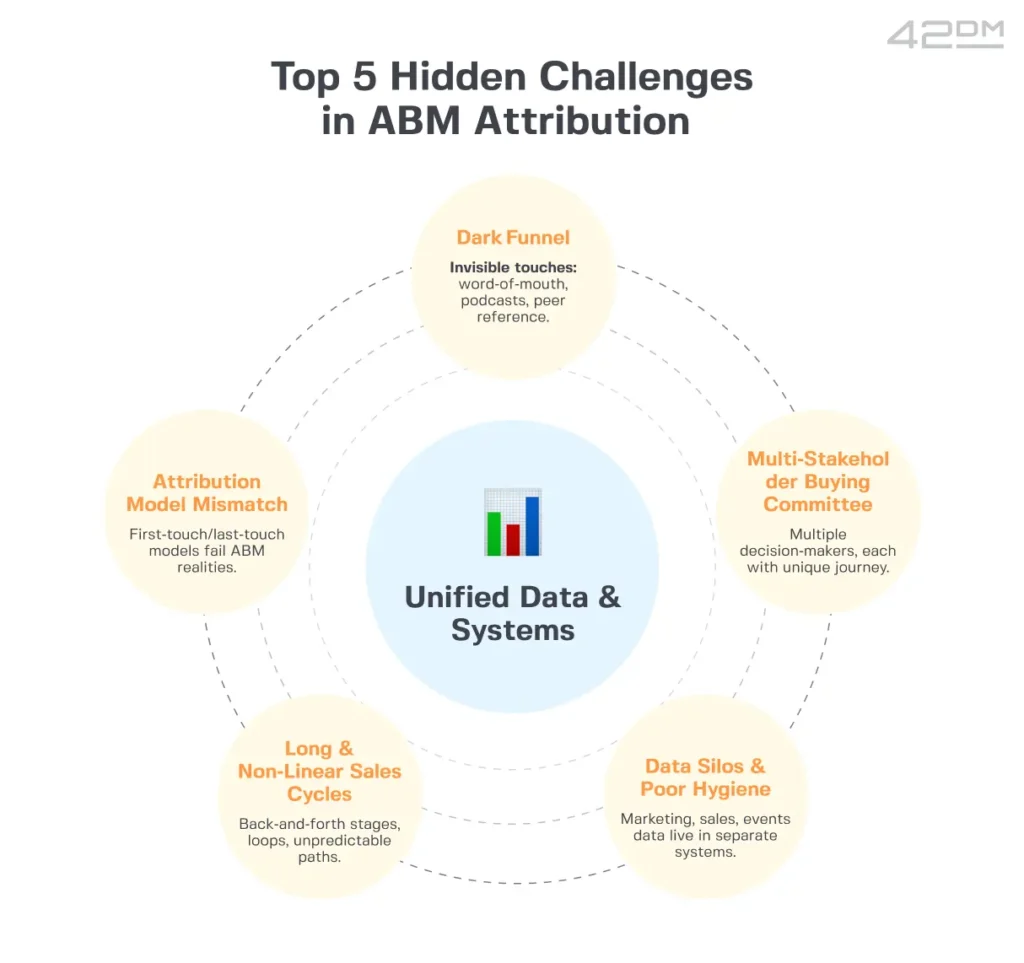
In B2B sales, a complex sales cycle with multiple stakeholders and a more complex sales cycle driven by longer decision processes make attribution even more challenging. Yet the journey is fraught with challenges—data integrity, organizational silos, opaque buyer journeys, and the notorious “dark funnel.” Let’s look at where the challenges lie and how we’re approaching them.
The Data Quality Conundrum
Data may be our guiding star, but only when it’s not leading us astray. Bad data clouds every decision you make, but ABM attribution models—first click, last click, linear—are particularly vulnerable to the quality of your inputs.
Duplicate records, outdated contacts, and missing intent signals can quickly transform a well-planned campaign into a wild guessing game. We’ve watched this play out over and over again. Taking regular data hygiene, validation routines, and cross-platform syncing into consideration, these efforts are what maintain the cleanliness of our attribution. Analytics tools play a crucial role in maintaining data quality and ensuring attribution accuracy by tracking and measuring marketing touchpoints across channels.
Without it, no matter how advanced the model, we’ll never receive insights we can rely on.
Bridging Sales & Marketing Silos
The key to success in ABM attribution is ensuring sales and marketing works like one cohesive unit. We counter that with a heavy dose of routine alignment meetings, joint dashboards, and transparent feedback loops. Involving the sales team in ABM attribution efforts is essential for accurate tracking, gaining buy-in, and ensuring both teams are moving prospects effectively through the buying cycle.
Once both teams are aligned on goals and clear definitions, the transition from blame games to collaborative wins is clear. Attribution and intelligence are crucial. It’s pretty obvious what success should look like!
It’s the only way to handle multi-touch journeys and complex buying committees while maintaining clarity.
Tracking Elusive Offline Interactions
Not every handshake or phone call leaves a digital breadcrumb. We record offline meetings as CRM notes and follow up to advise teams to document important exchanges. We also collaborate with customer success teams to capture additional touchpoints, ensuring more accurate attribution.
Including these touchpoints — such as events or direct mail — into our attribution models adds context. It ensures a more complete picture of what’s really moving the needle and leading to action.
Avoiding Common Implementation Pitfalls
We’ve learned the hard way that bypassing the planning phase or doing the tech integrations in haste only results in complications—trust us. To avoid these common pitfalls, it’s essential to have a clear attribution strategy in place so you can allocate resources effectively and optimize your approach from the start. Lack of stakeholder buy-in, skipped testing, and single attribution model dependency are time and credibility draining missteps.
We prototype small and learn big. We’re on the lookout for blind spots—particularly in the dark funnel, where intent is authentic but not detectable.
Tech: Your Attribution Superpower
The world of ABM attribution isn’t just about data aggregation. It’s all about using technology to turn millions of disjointed touchpoints into meaningful insights. Attribution is the secret sauce behind account-based marketing. It shows you what strategies, channels and account based marketing tactics really move the needle and get those deals in the door!
The rub? Because customer journeys are rarely a straight line. Website visits, white paper downloads, ad clicks, and yes, even offline referrals leave attribution trails across various platforms. Managing this data, particularly with today’s ABM tech stacks, can become complicated and disorganized quickly. A marketing automation platform and marketing automation tools help consolidate and organize data from multiple channels, making it easier to track and attribute touchpoints accurately. That’s where tech comes in — and where the right tech makes all the difference.
Essential Platform Integrations Now
In order for ABM attribution to be effective, our systems have to be able to communicate with one another. CRMs such as Salesforce, web analytics platforms, and advertising trackers are the base. Integrating data from all marketing channels is crucial to get a complete view of account engagement. When these tools work well together, we have the best data and the best insights at our fingertips.
Connected systems show you more than just who interacted, but the context around their interactions—where they did so, when, and how. A seamless flow of data between marketing and sales ensures that no handoffs get dropped—everyone is working from the same playbook.
Dedicated ABM Attribution Software
Dedicated ABM attribution software provides a whole new level of insight. Features such as multi-touch attribution models, automated journey mapping, and influencer tracking allow us clearer vision to identify which actions make the biggest impact. With dedicated software, you can track the effectiveness of each abm campaign and optimize abm campaigns for better results, ensuring your marketing and sales teams are aligned and focused on high-value accounts.
These tools not only save the time spent manually pulling and cleaning data, but save us to be more strategic with our time. The dedicated ABM attribution software serves as a central hub for all data, making collection and analysis a simple and efficient process.
Predictive Analytics for Foresight
Predictive analytics provide the crystal ball we always wanted for ABM. By looking at historical patterns, we can predict which accounts will be most likely to convert. Predictive analytics also help identify the right accounts and refine the target audience, ensuring ABM efforts are focused on high-value prospects.
This foresight allows us to optimize our campaigns in advance.
Visualizing Complex Account Data
Detailed, extensive information is pointless if we are unable to visualize what it all adds up to. These visualization tools turn that data overload into sharable, storytelling dashboards—heatmaps, journey flows, or account scorecards.
These visuals help not only convey these insights to one primary stakeholder, but allow us to iterate and improve our approach in real time. Visualizing customer engagement metrics enables teams to track how marketing efforts impact conversions and revenue, helping optimize ABM strategies for better outcomes.
Smart ABM Attribution Strategies
Smart ABM attribution strategies are like a detailed roadmap for a successful cross-country road trip. No more trial and error to find the freeway to fortune! As marketers, our experience has taught us that the most effective strategies are rooted in clarity, alignment, and ongoing evolution. A comprehensive marketing strategy and well-executed account-based strategies are essential for successful ABM attribution, ensuring targeted efforts and accurate measurement.
Smart ABM attribution isn’t just checking which campaign wins the gold star. Discover what’s truly driving revenue and engagement! This is true even with intricate buying committees and a myriad of online and offline touchpoints. Here’s how we navigate the labyrinth.
- Start With Crystal-Clear Goals
We begin by getting crystal clear on what success looks like for our team. This might mean winning larger enterprise deals, increasing the speed of sales cycles, or expanding further into targeted accounts.
These goals shouldn’t just be a North Star; they define what you measure and how you analyze every campaign. When our objectives tie directly to bigger business outcomes (like pipeline velocity or revenue closed), our attribution models become more meaningful.
Without this clarity, you can end up pursuing vanity metrics rather than actual movement toward your goals. - Map The Entire Account Journey
We know the account journey from first touch to closed deal is never that simple and never linear. We map every step: LinkedIn ad views, webinar signups, sales calls, even those mysterious “dark funnel” moments where buyers research us without raising their hand.
Multi-touch attribution models, such as W-shaped or time decay, start to show the importance of every interaction. Unlike others, they aren’t limited to the first or last touch.
This complete picture provides the ability to sharpen engagement tactics and make sure every touchpoint doesn’t fall by the wayside. - Prioritize Actionable Insights Always
So that we don’t drown in data, we prioritize actionable insights always, which inform our future actions. We determine what content assets move buying committees down the marketing funnel automation and when intent data is indicating a warm/hot lead.
By filtering to find what’s really relevant, we make analysis actionable, not just a pretty report. - Continuously Test And Optimize
Just like markets, our buyers are ever-evolving. We build in frequent A/B testing and optimization as just part of the process.
This means A/B testing attribution models, piloting new tracking tools, and recalibrating for changing customer behavior. This way, our attribution remains grounded in the real world and outcome-oriented.
Conclusion
ABM attribution isn’t merely a technical challenge! It’s a great way to really make the connection between what we’re doing and actual business outcomes. Taking a step back gives us the opportunity to look at the larger landscape. These attribution models allow us to better communicate the stories of what works and what doesn’t. Data, in this context, becomes less about numbers and more about people: the accounts, teams, and moments that shape our growth. With the right strategy + tools formula, 42DM ABM agency helps you establish trust between teams. A healthy dose of skepticism keeps us honest and forces us to make better, more informed decisions. ABM attribution isn’t about pursuing perfection. It’s all part of learning, adapting, and ensuring that we stay true to what it’s all about—making a real impact for our clients and our firm.


